Cosmosophy II
GA 208
Lecture V
29 October 1921, Dornach
Yesterday we discussed the way the inner and outer human form is created out of the universe. We also found that this was something people knew instinctively in earlier times. It is important, however, to note the following. In one of my drawings I showed that the whole zodiac can be seen to lie in the human form, but this had to be the form of the human embryo. If we draw this we have literally recreated the zodiac within the human form.
During life on earth between birth and death, human beings tear themselves away from this embryonic form. They certainly have their form given by the universe during the embryonic period, but they “stretch” during their time on earth, lifting the head up and out of the circle that reflects the zodiac. They then have the form given to them as embryos, but no longer allow it to relate to the fixed stars, and this means that human beings become able to take into the form of the head what they have brought with them from their previous life on earth.
Animals keep their backbones horizontal, and essentially continue much more in the position given by the zodiac, with the head merely attached to the front part of the backbone. This means that animals are not able to use the head to take in anything from a previous life. The situation is such that if we consider the human form in one respect, we would have to say that the human form based entirely on the zodiac would be like this (embryo). And if human beings continued to have this form throughout life, the form of the human head would not be able to take in the essential nature of a person which comes from the previous incarnation. By lifting the head out of that position, it becomes possible for the form to hold and protect the element that comes from the previous life.
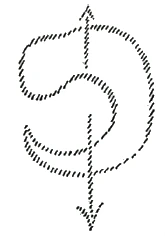
Human beings also lift the other side out of the embryonic form, which is the side that takes its orientation from the last four signs of the zodiac, from Archer, Goat, Water Carrier and Fishes. As we saw yesterday, this relates to life and conditions of life in the outside world—to hunting, animal breeding, agriculture and trade, or shipping. Human beings follow these pursuits out of will impulses, out of the system of limbs which they have lifted out of its orientation on the zodiac. The result is that everything people do holds the potential, or seed, for future lives on earth. Animals retain their orientation on the zodiac and are therefore unable to take in anything from a previous life on earth or to look towards any future life on earth.
Out of the profound wisdom people had as instinctive knowledge in the past they called the circle of constellations “the zodiac”.13Zodiac from the Greek and Latin zodiakus, derived from “circle of the figures”, being the Greek for the sculptured figure of an animal. Today we use not instinct but clear thinking to discover the same truths, and we consider the original wisdom human beings once possessed with growing respect.
So much, then, about the human form. Into this form is poured life, and we find this life localized in the human ether body just as we find form localized in the human physical body. It is quite right to consider the human physical body with regard to its form, for that is the essence of it. The ether body essentially represents life, and this is what we want to consider today. Yesterday we saw that the human form is really made up of twelve different forms and we made the attempt to study those forms. The human form as a whole, in its inner and outer aspects, arises from twelve individual forms.
Human life also has a number of levels, and in the first place these may be considered as follows.
The first, and to our everyday thinking this is not yet a level of life, is the life of the senses. Although they are part of the whole human being, the senses are so much at the periphery that we tend to forget that the life of the senses is the outermost layer of our life.
Moving inwards from the periphery—now thinking only in terms of life—we come to the life of the nerves, which is an inward continuation of the life of the senses just as the nerves go inwards from the sense organs.
The life of the nerves in turn is in touch with another level that develops in the living human being. I have shown some aspects of it on earlier occasions, when I drew your attention to the way we draw breath. We take in air and the air we inhale creates a kind of inner rhythm which continues through the spinal canal and on into the brain. There the life of the nerves comes in contact with the life of our breathing, which is the next level as we move inwards.
The life of breathing in turn connects with another level of life. The breath, we may say, continually renews the blood. Thus the breathing rhythm is connected with the blood rhythm and we can move on from the life of our breathing to the life that exists in the rhythm of the circulation.
The circulation, however, is also connected with the whole of metabolism; it takes in metabolism, and we thus come to the next level, the life of metabolism.
Metabolism stimulates the movements we make in the world around us. It is thanks to our metabolism that we are actually able to move around. The nature of the human—and also the animal—metabolism is such that the soul is able to use the metabolic processes to produce movements. In the life of movement we are again becoming part of the outside world, for anything we achieve at that level of life connects us with the outside world.
There is one more level of life: the life of reproduction. In movement we continually use ourselves up, and internal “reproduction” has to take place for the very reason that we are in motion. Instead of “life of movement”, we may thus also put “internal reproduction, or regeneration”, providing we remain inside the human skin. And when this reproduction occurs independently, it becomes life of reproduction in the true sense.
- Life of the senses
- Life of the nerves
- Life of breathing
- Life of circulation
- Life of metabolism
- Life of movement
- Life of reproduction
Yesterday we had twelve elements of form, today we have evolved seven levels of life, and it is true to say that in terms of the ether body, human beings live differently on each of these seven levels. If we are to take these things seriously, we cannot speak of a single kind of life that is all at the same level.
In the first place, then, our ether body may be said to live at the level of the senses, and this is a form of life that barely feels like life to us. Through it, we are involved in the outside world. If we take the eye, for example, we say the ether body is alive in the eye and in a manner of speaking enlivens it. It does however come in touch with a form of matter that is close to death in the eye, which is a living organ only in so far as the ether body enters into it. Apart from the ether body, the eye is really a physical apparatus.
Individual sense organs are always both a physical apparatus and penetrated by the ether body, each in its own particular way. Generally speaking, however, our sense organs are dead organs, except that the ether body enters into them. It would therefore be reasonable to say that the life of the senses is life in the process of dying.
The life of the nerves takes the experiences gained through the senses and makes them into something that can preserve the life of the senses. All lingering effects are due to the life of the nerves, therefore—lingering sounds, for example, and in the case of the eye, after-images. The life of the nerves, then, is a kind of resting life, or a life that holds and keeps.
The life of breathing gives image quality to the fleeting life of the senses that tends to preserve itself. We are able to have images of the outside world because the breathing rhythm is in touch with the currents that pass through the nerves. Ideas and abstract thoughts are still entirely bound to the life of the nerves, but anything to do with images is connected with the life of breathing. When we breathe we have creative life in us, a life we may call the image-creating life. This lives in the human form and therefore also takes part in the human form.
We have seen that the human form arises out of the zodiac, and because the creative life that comes with our breathing lives in the human form, it also has part in the whole outer form that has been created out of the starry heavens.
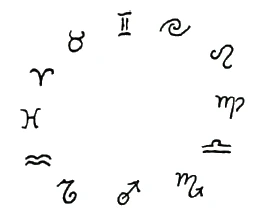
This form is therefore also part of the inner aspect of the human being. And it is thanks to our breathing that we have not only the contents of our conscious mind but also images of all our internal organs, images based on the outer form. Our internal organs therefore arise at first in a roundabout way—as images created in the breathing process. They do not yet have substance at this point. The breath creates an image of the internal human being. With our breathing we are in the outside world, moving within the zodiac with the earth, and we are continually inhaling the images of our internal organization.
These images are inhaled from life outside us. This, then is our creative life. The images we inhale are spread through the whole organism by the life of circulation. This and the life of breathing take human beings to the point where they are inwardly image of the world. Thus we may say: 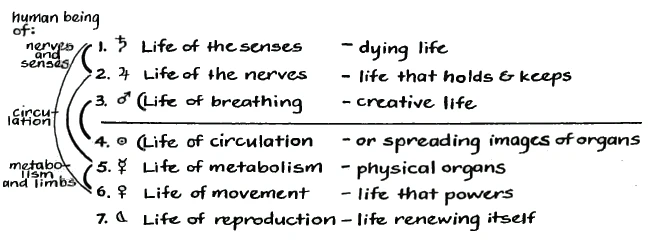
The life of circulation is in touch with the life of metabolism, with the result that the images are given physical substance and physical organs develop on the fifth level of life. Matter infiltrates the images; it suffuses or tinges them. Thus the upper human being creates images in the life of breathing and these images are made tangible reality by the matter that infiltrates and tinges them.
Energy then enters into the physical organs from the life of movement. We may put it like this: We have physical organs and here we have life that generates power in the organs. The life of reproduction, finally, renews itself.
You can also see how the threefold human being arises: nerves and senses, circulation and rhythm, and metabolism and limbs, or metabolism and movement. Reproduction, finally, gives rise to a new human being.
The attributes I have added on the right (Fig. 14) give you an idea of the differences between the levels of life. Living in the senses, our ether body is in a kind of life that is dying. In the life of the nerves, the currents in the nerves, it is in a life that holds and keeps. The breathing life is where our ether body truly becomes a body of creative powers that designs images. The life of circulation ensures that those images become our whole internal organization. Physical substance is then brought in through the life of metabolism. The ether body enters into metabolism and suffuses the actual body of creative powers with matter. Subjective human energy is added through the life of the limbs, and so on.
The instinctive wisdom of old gave people understanding of this, too, and they knew, therefore, that human beings take in the life that is outside and develop it further inside them. That is more or less how the sages of old would see it. They would say: Let us take the outermost layer of the universe that is around the earth, then the next, and the next. The outermost layer is closest to the fixed stars in the sky, to the universe to which we owe the human form. Human life, they would say, does not come from the fixed stars, however, but from the planets in the sky. (Fig. 15).
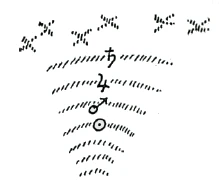
They would first of all speak of Saturn, Jupiter, Mars and the sun. If we consider the true nature of the sun—this is something I have said many times before—it differs from the other planets in so far as it presents itself as a source of light. This is also why in popular astronomy it is called a fixed star. The other planets do not appear as light sources but as images. This is why it is said in popular astronomy that their light is borrowed light, for they reflect the light of the sun. Just consider the difference between the sun, which lets its own essential nature emerge with the light, and the other heavenly bodies, the planets, which merely present an image of their outer nature, or of whatever they have on the surface, making this visible by reflecting the light of the sun. It is a major difference. And being the source of light, the sun is also the source of life.
It is also the source of something else. At all times, even when people had only instinctive knowledge, it was said that the sun was threefold, the source of light, life and love. This trinity is to be found in the sun.

No need to go against the Copernican system today, you can keep it and still understand what the ancients meant with their system, based on instinctive perception of the cosmos. Let us assume that, in Copernican terms, we have the sun at the centre—or at a focal point, if you like, but we can ignore that for the moment. Mercury, Venus, earth and Mars—we can ignore the minor planets for present purposes—Jupiter and Saturn are in orbit around the sun. But now we’ll look at it like this:
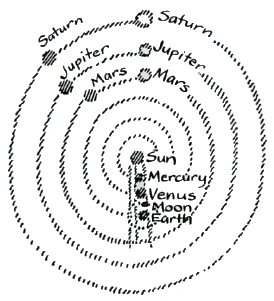
Let us say, and this is certainly also possible, that we have Saturn, Jupiter and Mars here, and then come sun, Mercury, Venus and earth, with the moon, however, which we’ll position here.
It is not essential, of course, to take this particular position, I am merely presenting it to show you that even with the Copernican system it is possible to get the sequence that was thought to be the right one in ancient times: moon, Venus, Mercury, sun, Mars, Jupiter, Saturn. All we need is for the relative positions to be such that the earth is to one side of the sun and the outer planets are somewhere on the other side. It is not necessary to have this kind of opposition or conjunction—which may happen in alternation—but the sequence is certainly feasible. And it is the sequence that was in people’s minds out of the old instinctive wisdom. This sequence seemed important to them.
The ancients would say: Let us think of the human beings here on earth. They are exposed to the universe. They experience the rays of the sun as their source of light, life and love. These three enter into them from the sun. Yet human beings are also exposed to the image quality of Saturn. If they were only exposed to the life of the sun as they developed on earth they would not be able to develop the life of the senses. Thus the eyes would not become a distinct physical apparatus but would be just like any other part of the human body—muscular organs, or vessels, or the like. Continuously exposed to the sun, human beings would not be able to develop eyes, nor any other senses. They are able to do develop them because Saturn, the outermost planet, reduces the influence of the sun. Saturn dries the vessel out, as it were, and this, roughly speaking, produces the physical apparatus. The ancients had as instinctive knowledge what we are discovering again today: The life of the senses develops under the influence of Saturn.
Human beings also would not be able to develop the life of the nerves if they were continuously exposed to the sun. Thanks to the influence of Jupiter, the life of the nerves dries up and does not become as vital as the muscles and similar organs. The ancients would say: The life of the nerves is stimulated by Jupiter.
Saturn orbits the sun in about 30 years. During their life on earth, human beings have it happen about once that Saturn is blocked out by the sun, in a way. If someone has the good fortune to have Saturn blocked out very strongly by the sun, a powerful sun life dawns in their life of the senses. We might say that their eyes or other senses are stimulated—the eyes are in fact least affected, but they make the best example, being so obvious. So if once during life on earth a person is in the position where Saturn does not influence the senses, that person may discover that a specific cosmic influence comes in through the senses. The individual is given a stimulus and is strengthened in the sphere of the senses.
People try to explain these things in all kinds of ways. There is a considerable literature on the subject in America. William James, for instance, wrote of all kinds of “awakenings” that happened in people’s lives.14William James (1842–1910), American physiologist and pragmatic philosopher, in his book The Varieties of Religious Experience (1902), chapter 3: The Reality of the Unseen. If you read his books and those of his followers you’ll find that a particular phenomenon occurs when someone receives a special stimulus at some point in time. These people have no idea as to the cause; they do not know that this is due to the position relative to Saturn or Jupiter. When the life of Saturn is blocked out, the life of the senses receives a special stimulus; when the life of Jupiter is blocked out, which happens all the more easily because Jupiter takes only 12 years to orbit, the life of the nerves is stimulated.
All these things are said to be in the subconscious, which is an absolute sludge tank today for people like William James and all psychoanalysts. This subconscious of theirs is a negative term, a waste bin for all the things that cannot be explained. Everything has to go in there; there you’ll find the hidden “provinces” of the soul that will react occasionally, and so on. It would certainly be highly desirable to take a good look at those pragmatic and psychoanalytical ideas one of these days.
The third planet, Mars, reduces heaving life to the point where breathing becomes possible. Mars, too, may be blocked out by the sun, and the life of breathing then receives a special stimulus. Mars orbits quite rapidly, taking about two years, and everybody therefore gets certain stimuli in the breathing life, the life of images. These stimuli are not always of the first quality, but people become poets or composers, or something like that, through receiving this stimulus in their breathing life. It does not go deep enough to make people like William James want to investigate and speculate; it seems quite clear to them. People with the old, instinctive wisdom thus felt that Mars stimulated the breathing life.
The life of the sun arouses light in the outside world, love in our hearts, and life in our dealings with the outside world. The location for this is midway between the life of breathing and the life of circulation, as the ancients also knew. Between those two lives lies the heart, which does not act as a motor but reflects the interplay between circulation and breathing.
Next we come to metabolism. People who had the old wisdom looked at Mercury not to see how far the sun is able to block it out, the way it does with the other planets, but how far Mercury itself blocks out the sun for the earth. Its position between sun and earth was considered to be the most important aspect, just as in the case of Jupiter the position beyond the sun was considered most important. When Mercury blocks out the sun, the life of the sun is reduced. As the life of the sun is weakened, this weakened life stirs inside human beings. If it were not reduced, people would immediately spit out any food or drink they had taken; they would not tolerate anything that comes from the outside world. They would then get out of the habit of eating, finding it too much of a bore. That is how powerful the life of the sun is in us. If we had only the life of the heart, or the sun, we would not be able to digest anything and immediately spit, or indeed vomit, everything out again. We owe the development of our metabolism to the fact that the life of Mercury weakens the life of the sun a little in this respect. The ancients therefore thought that the Mercury principle came between the life of circulation and the life of metabolism. The Mercury principle thus pushes physical matter through the human organism and into its individual organs.
Energy comes in through the life of movement which depends on Venus life, just as the life of metabolism depends on Mercury life. The ancients therefore ascribed to Venus the power that streams through the human being, this inner self renewal, the feeling that there is another human being, an energy human being, inside one.
The life of the moon, which is close to the life of the earth, does more than reduce the life of the sun and thus enable human beings to digest physical matter and process energies. The background to reproduction is something I have spoken of before: a space is created, with matter pushed back at the organic level, as it were. The embryo is able to develop because matter is pushed aside and in energy terms the embryo is organized from the cosmos. In this respect the life of reproduction depends on the moon life.
Yesterday I spoke of the relationship of the human form in its twelve aspects relating to the fixed stars. Today I have tried to show you how the new science of anthroposophy is in agreement with the instinctive wisdom of old in saying that the different levels of human life are connected with the life of the planets in the cosmos. Depending on the position of the earth in relation to the different members of the planetary system and the sun at its centre, life is modified in many different ways. Life is made to die, it is preserved and made creative in the upper human being. It is reduced in the lower human being so that physical matter and energies can be taken up from the earth. Human beings simply take the earth’s power of repulsion, make it their own and in this way develop the power that is in their own organs, and so on.
We see, then, that human life, too, comes from the cosmos. Looking up to the fixed stars, we see the zodiac as representing the principles that give rise to the human form. Observing the movements of the planets, we find the explanation for the different levels of human life. We look to Saturn for the life of the senses, to Jupiter for the life of the nerves, to Mars for the life of breathing, which is active in images.
Let us take a special look at this life of breathing. I told you that the images are received from the cosmos: form. The movements experienced in the zodiac stream inwards as images of our internal organs. Between birth and death, human beings are on earth, however, and the lower acts into the upper, with the result that everything has its polar opposite. The images enter into us and become suffused with matter, otherwise we would have no internal organs. But there is also always a counter process. So we are able to say that when we breathe, the images are pushed inwards, the image of the kidney, for example.
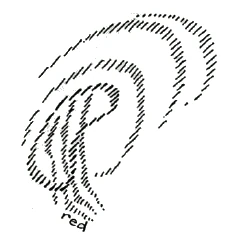
Matter then fills this out (red); but the opposite also happens, this time in an upward direction, with the images thrown back, as it were, like an echo, but do not think of this as a once-only event. The organs are in existence, having been developed in the early stages of earth existence; but the counter action may go on all the time.—The role played by the soul element in this will be considered tomorrow.
Consider each on its own, therefore. You take in the images of your internal organs with the life process. Then comes the counter action, in which the echoes of those images rise up again, as does the zodiac, especially with the life of breathing in it. Well, just think of your ears, and there you have the counter process. These images are created and go out into the air—they are the vowels and consonants! The vowels come more from the planets, the consonants from the zodiac. The counter process to the images coming in is reflected in speech. Consonants and vowels are pushed into us, as it were, to be the foundation for our organs. Anything that is more by way of form inside us comes essentially from the zodiac, anything that is more by way of life comes essentially from the planets. If the counter action relates more to life, we produce vowels, if it relates more to form, we produce consonants. All this is to some extent connected with the life of breathing, and we can see that quite clearly in speech.
You see, it is not really a good idea to try and understand the human being by putting him on the dissecting table and investigating what lies inside the skin. The result of this is no better than if someone were to take a magnetic needle and ignore the fact that the earth itself is a large magnet, making one end point north and the other south. If anyone were to insist on producing a theory that the magnetic needle takes that position of its own accord, ignoring the fact that the forces of the earth give it that particular direction, it would be just like anatomists and physiologists trying to understand the human being on the basis of what is to be found inside the skin. You cannot understand the human being on the basis of what lies inside the skin. All the people who seek to explain speech and language on the basis of what lies inside the human being are also working at the level of that explanation for the function of a magnetic needle. The truth is that human beings take their form from the life of the fixed stars and reproduce this as an echo, which gives rise to the consonants. They take in the movements of planetary life which influence their own life. The life of breathing in particular creates images of all this. The counter action then produces the vowels. Human speech can only be understood if consonants are seen in relation to the constellations of fixed stars and the vowels in relation to planetary conjunctions and oppositions. Thus human speech and language is seen to derive from the whole cosmos.
The sun, here (horizontal line in Fig 14), marks the middle. Take the three upper principles and you have the upper human being. Take the three lower principles and you have the lower human being. The reproductive life then gives rise to a new human being.
Take the life of breathing and the life of circulation. The latter essentially reflects the planetary movements. Our blood circulation is basically no more than an image of planetary life. We may thus also say that the vowels come from the life of the circulation and the consonants from the life of breathing. And now we get another strange relationship. We can relate the life of metabolism to the life of the nerves and the life of movement to the life of the senses. The life of the senses, however, relates to the movements of Saturn, which may be said to be closest to the zodiac, just as human beings present themselves most clearly to the outside world in their life of movement. If we want to show how human beings reflect the secrets of the cosmos, we have on the one hand the life of the senses and on the other hand the life of movement and this gives us—eurythmy. Eurythmy is the direct image of the relationship human beings have to the cosmic periphery. I just wanted to mention this briefly.
My purpose today has been to show you how the human being relates to the cosmos in regard to life. Yesterday it was my purpose to show the relationship of the human being to the cosmos in regard to form. Tomorrow we’ll consider the third aspect of the relationship between human being and cosmos—the soul. After considering the human soul in relation to the life of the cosmos we will have the three aspects of form, life and soul.

